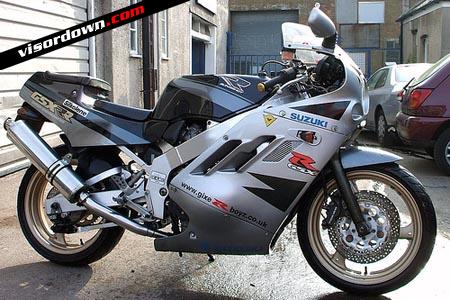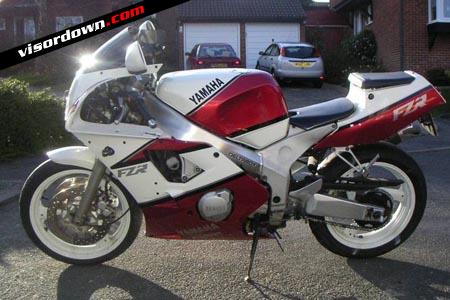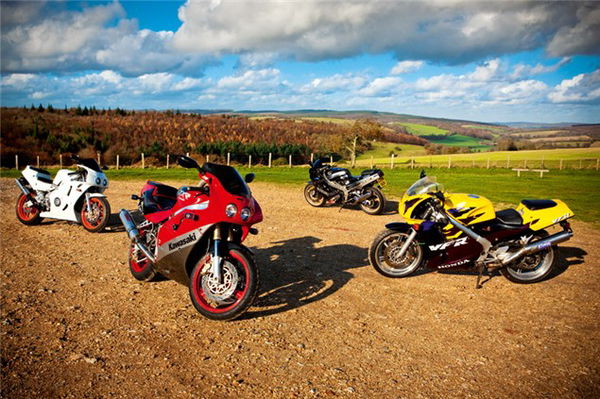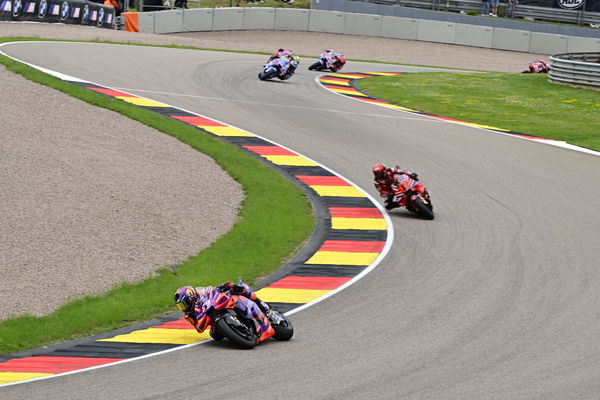Have race rep 400s had their day?
End of the road for much-loved pocket rockets?


WHEN 400cc sportsbikes hit Britain's shores in the early 1990s up and coming sportsbike newbies could hardly believe their luck. For the first time ever, new riders could get their eager hands on machines that looked and handled like a big-bore racebike, without frightening themselves silly or paying sky-high insurance premiums.
Up until then inexperienced riders, or those a bit short in the leg, were lumbered with either a low-slung custom or a sexless commuter. Neither were tempting fodder for riders that had their heart set on a cutting-edge sportsbike.
The source of these beautiful miniature race reps was Japan's home market, as the country's stringent transport laws made motorcycles over three years old almost redundant. But even though Japan had turned its back on these exquisite race replicas, it didn't take long for someone to realise there was a massive market for them in Britain. Japan's loss was to be our gain and the grey import bike scene was born.
The Importer
BAT Motorcycles in Kent were the first UK company to get involved in 400cc grey imports. Martin Davidson, a key figure in BAT's success, tells us how it all started:
"Japanese riders were restricted to 400cc because of the country's licensing laws. When the bikes were three years old they weren't wanted, so we bought them by the container load - most of them were in superb nick.
It was an exciting time because you didn't really know what you'd be getting in each shipment. There'd be 400s, two-stroke 250s and plenty of jaw-dropping exotica you just didn't normally see in Britain. The Japanese produce stunning bikes for their home market.
Did you sell many?
"It was an unbelievable time. We sold everything we could get our hands on. New riders were elated there was something on offer besides a CB500, a Bandit or a cruiser. It gave riders a tempting alternative if they couldn't afford to buy and insure a 600cc sportsbike. The ladies love them, too, because they could reach the floor and look cool. 400cc race replicas changed the British bike scene forever."
So why aren't they imported anymore?
"MSVA (Motorcycle Single Vehicle Approval) wrecked everything. Before it appeared in 2003 we would service the bikes, change the tyres, MOT them and they were ready for the showroom. The stringency of MSVA testing made importing 400s financial suicide. It's a bloody shame because there are no fresh bikes coming into the country."
The Salesman
Visordown spoke to Gary McKay at DK Motorcycles in Stoke on Trent, another grey import specialist that's been bringing bikes into the country for the last 20 years. Their showroom still has a fair number of grey imports but their stock is dwindling due to MSVA regulations.
Is there still a market for 400s?
"There's still a huge market for 400cc sportsbikes but the quality of what's left on the secondhand market is diminishing year-on-year now no one's importing fresh stuff from Japan. MSVA's ruined the show. I could sell a whole showroom full of them if I could find decent quality stock. Finding it's the problem."
Which 400s are most popular?
"Hondas mainly. VFRs, RVFs and baby-Blades - the CBR400RR. Kawasaki officially imported the ZX-R400, so there are quite a few decent examples around but that ceased production in 2003. On the whole it's difficult finding a decent low mileage 400 that hasn't been crashed, tracked or just plain neglected. Suzuki GSX-R400s and Yamaha FZR400RRs aren't so popular."
The Market
We did a national search on the most popular race replica 400s for sale. Honda VFRs were the most plentiful, RVFs were the most expensive and Suzuki GSX-Rs the least popular. It's worth noting the cheapest and most expensive CBR400s (£950 and £2395) were made in the same year:
Honda VFR400
45 available
Cheapest - 1990 model costing £995
Most expensive - 1992 model costing £2695
Honda RVF400
15 available
Cheapest - 1993 model costing £1995
Most expensive - 1998 model costing £3999
Honda CBR400RR
25 available
Cheapest - 1990 model costing £950
Most expensive - 1990 model costing £2395
Kawasaki ZX-R400
20 available
Cheapest - 1994 model costing £995
Most expensive - 2003 model costing £3250
Suzuki GSX-R400
9 available
Cheapest - 1991 model costing £995
Most expensive - 1992 model costing £1899
Yamaha FZ-R400RR
12 available
Cheapest - 1988 model costing £875
Most expensive - 1991 model costing £1999
The Buyer
Visordown spoke to Mark Oddi, a fireman from Oxford, who passed his test six years ago and started searching for a VFR400 straightaway:
"It looked at fifteen before I found the right one. I'd have probably bought sooner but my instructor came with me and insisted we weren't going to buy any shit. I learnt a hell of a lot in that time. Some had been crashed, others had lousy gearboxes and most had tatty bodywork. I almost gave up in the end. Eventually we found an absolute minter, but my joy wasn't to last long as I got swiped off it the following week when some idiot jumped a red light. That was over six years ago, so I'd imagine finding a decent one now would be a total nightmare."
The Bikes

Honda VFR400 NC30 - 1988 - 1994
There are various guises of VFR400 but we'd suggest looking for the NC30 model as it's the best looking of the bunch with endurance-style fairing and single sided swingarm - a mini RC30. The bikes were officially imported for a short time and UK versions are unrestricted - watch out for strangulated imports, as restoring them to full power can be an expensive process. In 1994 a new NC30 cost a whopping £6500 - over a grand more than a new CBR600 cost at the time.
Known vices:
Pre-1990 machines had inferior suspension
Regulator/rectifiers blow
Genuine Honda bodywork's expensive
Home servicing's as fiddly as it gets

Honda CBR400-RR 1988 - 1997
The Baby Blade is just what it says on the tin. Built like a Fireblade and looks like one too. Like the VFR400, there are various guises of CBR400. Our pick would either be the Gull Arm NC29 or if you can stretch to it an RRP onwards. Expect to pay £1500 tops for Gull Arm and £2500 for a late model RRV. The beauty of the CBR over the VFR or RVF, is its simplistic reliable 16-valve inline four engine. The low seat and slim profile of the Baby Blade makes the Honda an ideal bike for small riders.
Known vices:
Downpipes rot
Paint flakes off wheels (early models)
Cam rattles
Regulator/rectifier issues

Honda RVF400 NC35 1994 - 2000
The RVF took over from the NC30, mimicking its bigger brother, the RC45. It was much the same as an NC30 but with a modified frame, USD forks, retuned engine and 17-inch rear wheel (NC30 had an 18-incher). It was never an official UK import but soon became extremely desireable. Expect to pay over £4000 for a cherished, low mileage example. The RVF is probably the most finely crafted sports 400 ever built. Exquisite.
Know vices:
Many have been raced
Loads have been dropped
1st - 2nd gear gets clunky when worn
Fiddly to service
Spare parts expensive

Kawasaki ZX-R400 1995 - 2003
The little mean-greenie was an official UK import up until 2003, which means you should stand a better chance of finding a decent example. That said, production racers loved the Kawasaki's solid handling, rev-happy engine and genuine 135mph top speed - so check thoroughly to see if it's been on track.
Known vices:
Downpipes rust
Discs warp
Bodywork paint's thin
Wheel paint flakes on early models

Suzuki GSX-R400 1988 - 1998
A decent example of the mini-GSX-R is probably the hardest 400 race replica to find. The engine and running gear's pretty dependable, although electrical and build quality issues can effect older bikes. Not many were imported, plenty became hooligan tools and not many mint examples remain. The GSX-R still has a loyal following though (checkout gsxr400.com) and rightly so, as it's a brilliant bike when looked after.
Known vices:
Starting problems (a new Suzuki CDI's over £600)
Plenty have been crashed
Bodywork hard to source

Yamaha FZR400RR 1992 - 1996
The FZR400RR was imported from 1992, taking over from the single-seat 'P' version, which was imported for a single year in 1991. The Yamaha's 16-valve, liquid cooled engine produces 65bhp, with help from Yamaha's exhaust powervalve (EXUP). The FZR has a total dry weight of 165kg. In its last year on sale in the UK, Yamaha retailed the tiny 400 at a whopping £6749. No wonder they sold so few.
Know vices:
Burn oil
Grabby clutches
Seized brake callipers
Many crashed/raced
EXUP valves/cables corrode
So have they had their day?
Well, yes and no. The lack of fresh bikes from Japan means we're going to have to look after what decent examples are left in the UK. There's no doubting all the 400s we've listed here are cracking bikes, but if you want one you'll need to go to some effort to find a decent example. Just look at how few we found on sale, compared to the few hundred CBR600s that are available right now. If you're new to biking then take someone along with you when you're looking for a bike, especially something as fickle as a complicated Honda V-Four. Decent examples are getting hard to find and lousy ones are a money-pit waiting to happen.
There's not enough time to cover every model and every fact, so if you're still wondering 'what if?' then get surfing on one of the websites below. They're packed with really useful information gathered by passionate owners that know their bikes inside out.
Useful web addresses












